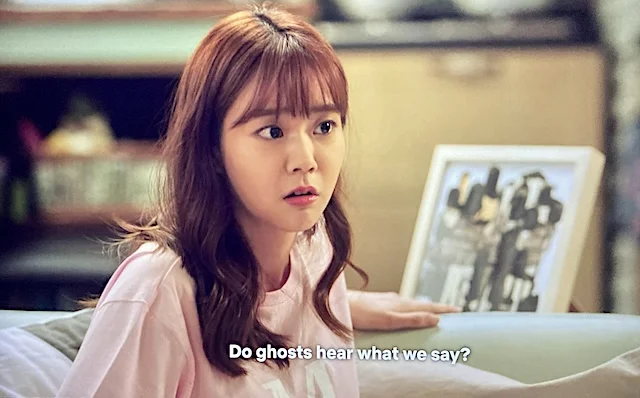The tenor of
The Age of Youth is heralded in its opening theme,
Dick and Jane, by Sydney York. The bubbly, even frenetic tune takes you on a journey that, at its end, pulses with dissonance. Most dramas I've watched over the last nine months have dark themes running parallel to romance, yet none have managed to weave together five distinct character threads, each with its its own trauma, as well as
The Age of Youth, directed by Lee Tae Gon and written by Park Yeon Sun. Although each character, aged 20 to 28, is on their own path with work, school, friends, family, and love, they come together at their shared apartment called, ironically or not, Belle Epoque. Over the course of a season they learn how little they know about each other's past and present. As one character slowly unfolds in the presence of their housemates, so do the others, with varying levels of conflict and resolution.
 |
| Yoo Eun-jae |
The show begins with Yoo Eun-jae, played by Park Hye-su, and her first day in Seoul, on campus, and at Belle Epoche. She is insecure and terribly yielding, and as anyone who has found themselves inserted into the lives of others knows, no less in the personal space of home, the experience can be intimidating. But Eun-jae is also troubled by her past and suppresses it, and with that, her emotions. Her subdued lead character is contrasted, at the end of the first episode, with the appearance of effervescent Song Ji-won, played by Park Eun Bin, whose only concern appears to be an inability to land a boyfriend. As it happens, these two opposite personalities are drawn to each other as the younger Eun-jae looks up to Ji-won and finds, maybe, a mother or sister-figure who is willing to stand up for her.
 |
Song Ji-won
|
Ji-won is outgoing and vivacious, but she does not know what troubles her, and her buoyant character can feel superficial, at times, in comparison to her housemates whose issues are revealed more quickly than hers. Ji-won's metered reveal comes in the form of her fictions, shared at home and at school, across several episodes deep into second season. Despite this, you like Ji-won -she's
smart, outspoken, witty, brings people together and in so many ways seems to have it together, if only it weren't for that unknown nagging at her.
 |
| Good question, Jung Ye-eun |
The stories of Eun-jae, Jung Ye-eun, Yoon Jin-myung, and Kang Yi-na drive the first season. As their secrets unfold, bonds are built, and believably so. Voice-over is used to convey the thoughts of all the
housemates, although I was particularly drawn to Yoon Jin-myung's internal dialogue. I imagine, at this age, that I would have found these portraits insightful throughout the psychological tumult of my twenties. Although the program had low AC Nielsen ratings in its broadcast season in Korea, its excellent script and word of mouth have kept it alive on Netflix.
 |
| Yoon Jin-myung |
When people ask which Korean drama they should watch, The Age of Youth always lands among my top five. I think this is because it bests most shows in the young friends genre in Korea and even globally, but also because it disposed of so many common Kdrama vignettes filled with umbrellas, wrist-grabbing, and the lot. It is a show that takes the time to develop each Belle Epoche character so that each has her own specific gravity; all are relatable, even if you do not share their story.
 |
Kang Yi-na
|
While much is resolved by the end of the first season's 12 episodes, what ails Ji-won only began to rise to the surface by then. So The Age of Youth returned with a second season to further explore the lives of Belle Epoche's young women. However, I found that the majority of the second season's 14 episodes to be, at best, sufferable. The replacement of actor Park Hye-su with Ji Woo as Eun-jae was jarring, but that combined with the narrative focus on her emotional, internal struggle with feelings for her ex-boyfriend was exhausting. What was previously relatable in Eun-jae became just shy of pathological, and although her troubles somewhat understandable, I think the writers simply gave us too much of it. At least they made space for character Jung Ye-eun to deal with her post trauma stress and Yoon Jin-myung to discover how to reach outside her tightly-defined boundaries, as well as the entry of a new member of the household, Jo Eun.
 |
Yi Na is a novice driver...
|
The second season begins memorably with the first episode's comedic car ride and then, leaping over much of the middle episodes, finishes well with Ji-won's growth into a mature, investigative journalist in the final episodes. If it weren't for her story, I would have found it difficult to complete season two. When first season success leads to demand for a second season, the excitement doesn't always translate into production. Beyond the demands business can place on creativity, the original project can also exhaust the creative energy needed to breathe life into a second season.
This may be the case for Extraordinary Attorney Woo, too, although I have yet to hear much recently about that possible second season. As much as the character Attorney Woo placed Park Eun Bin on a global stage, Ji-won was her break-through role -one in which you will see hints of the future Attorney Woo. But don't get me wrong -the entire cast of The Age of Youth makes the show worth watching, and watch you should.
































